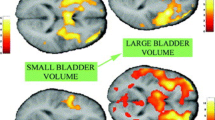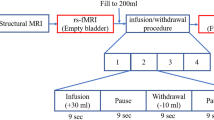Abstract
Objectives
To investigate whether patients with overactive bladder syndrome (OAB) have brain volume changes using voxel-based morphometry (VBM) and correlations with clinical tests.
Methods
With institutional review board approval and after obtaining written informed consent, structural magnetic resonance imaging data were prospectively acquired in 28 patients and 28 control subjects. OAB symptoms were assessed using the OAB symptom score (OABSS) scale. The gray matter volume (GMV) of each voxel was compared between the two groups while controlling for the effects of age, sex, and education level. Correlation analysis was performed to identify correlations between abnormal GMV regions and OABSS scores in patients. Multiple comparisons were corrected using a false discovery rate (FDR) method.
Results
Patients with OAB exhibited a GMV reduction in the right cerebellum, bilateral hippocampus, left insula, right superior temporal gyrus, left anterior cingulate gyrus, bilateral caudate nucleus and right middle frontal gyrus. Furthermore, there was a significant negative correlation between the local GMV of the right cerebellar hemisphere and OABSS score.
Conclusions
Patients with OAB have abnormal GMV in brain regions localized within the brain-bladder control network. It deepens our understanding of the structural changes in the brain area of the network. The patterns of structural reorganization in patients with OAB may provide useful information in the neuropathological mechanisms of the OAB.


Similar content being viewed by others
References
Smith AL (2018) Understanding overactive bladder and urgency incontinence: what does the brain have to do with it? F1000 Research 7:1869
Kitta T, Mitsui T, Kanno Y, Chiba H, Moriya K, Shinohara N (2015) Brain-bladder control network: The unsolved 21st century urological mystery. Int J Urol 22(4):342–348
Ridgway GR, Henley S, Rohrer JD, Scahill RI, Warren JD, Fox NC (2008) Ten simple rules for reporting voxel-based morphometry studies. NeuroImage 40(4):1429–1435
Homma Y, Yoshida M, Seki N, Yokoyama O, Kakizaki H, Gotoh M, Yamanishi T, Yamaguchi O, Takeda M, Nishizawa O (2006) Symptom assessment tool for overactive bladder syndrome–overactive bladder symptom score. Urology 68(2):318–323. https://doi.org/10.1016/j.urology.2006.02.042
Sepehry AA (2014) Self-rating depression scale (SDS). Springer, New York
Wang W (2011) Confirmatory factor analysis of the Zung self-rating Anxiety Scale. Chin J Health Psychol 19:781–782
Mahendran R, Chua J, Feng L, Kua EH, Preedy VR (2015) the mini-mental state examination and other neuropsychological assessment tools for detecting cognitive decline. Elsevier Inc., Amsterdam
Manto M, Nordeyn OBT (2013) The Contributions of the cerebellum in sensorimotor control: what are the prevailing opinions which will guide forthcoming studies? Cerebellum 12(3):313–315
Huang TF, Yang CP, Yang SL (1979) The role of the fastigial nucleus in bladder control. Exp Neurol 66(3):681
Lars M, Bertil FMB, Flavia G, Michael K, Brigitte S, Kurtz M, Spyros K, Ulrich M (2014) Supraspinal control of urine storage and micturition in men—an fMRI Study. Cereb Cortex 25(10):10
Nardulli R, Monitillo V, Losavio E, Fiore P, Megna G (1992) Urodynamic evaluation of 12 ataxic subjects: neurophysiopathologic considerations. Funct Neurol 7(3):223–225
Stevens FL, Hurley RA, Taber KH (2011) Anterior cingulate cortex: unique role in cognition and emotion. J Neuropsychiatry Clin Neurosci 23(2):121–125
Arienzo D, Babiloni C, Ferretti A, Caulo M, Gratta CD, Tartaro A, Rossini PM, Romani GL (2006) Somatotopy of anterior cingulate cortex (ACC) and supplementary motor area (SMA) for electric stimulation of the median and tibial nerves: an fMRI study. NeuroImage 33(2):700–705
Griffiths D, Tadic SD (2007) Bladder control, urgency, and urge incontinence: Evidence from functional brain imaging. Neurourol Urodyn 27(6):466–474
Critchley HD, Wiens S, Rotshtein P, Öhman A, Dolan RJ (2004) Neural systems supporting interoceptive awareness. Nat Neurosci 7(2):189–195
Komesu YM, Ketai LH, Mayer AR, Teshiba TM, Rogers RG (2011) Functional magnetic resonance imaging of the brain in women with overactive bladder: brain activation during urinary urgency. Female Pelvic Med Reconstr Surg 17(1):50–54
Tai C, Wang J, Jin T, Wang P, Kim SG, Roppolo JR, de Groat WC (2009) Brain switch for reflex micturition control detected by FMRI in rats. J Neurophysiol 102(5):2719–2730. https://doi.org/10.1152/jn.00700.2009
Matsuura S, Kakizaki H, Mitsui T, Shiga T, Koyanagi T (2002) Human brain region response to distention or cold stimulation of the bladder: a positron emission tomography study. J Urol 168(5):2035–2039
Yamamoto T, Sakakibara R, Nakazawa K, Uchiyama T, Shimizu E, Hattori T (2009) Effects of electrical stimulation of the striatum on bladder activity in cats. Neurourol Urodyn 28(6):549–554
Yau Y, Dadar M, Taylor M, Zeighami Y, Fellows LK, Cisek P, Dagher A (2019) Neural correlates of evidence and urgency during human perceptual decision-making in dynamically changing conditions. bioRxiv:84775. https://doi.org/10.1101/847756
Zhang H, Reitz A, Kollias S, Summers P, Curt A, Schurch B (2005) An fMRI study of the role of suprapontine brain structures in the voluntary voiding control induced by pelvic floor contraction. NeuroImage 24(1):174–180
National Clinical Guideline C (2012) National Institute for Health and Clinical Excellence: Guidance. In: Urinary Incontinence in neurological disease: management of lower urinary tract dysfunction in neurological disease. Royal College of Physicians (UK), National Clinical Guideline Centre, London. https://www.ncbi.nlm.nih.gov/books/NBK132831/pdf/Bookshelf_NBK132831.pdf
Porter AB, Healy L, Foster NL, Josephs KA (2007) Compulsive urination as a presenting symptom of frontotemporal dementia. Eur J Neurol 14(8):e16–17. https://doi.org/10.1111/j.1468-1331.2007.01864.x
Jang HJ, Kwon MJ, Cho KO (2018) Central regulation of micturition and its association with epilepsy. Int Neurol J 22(1):2–8. https://doi.org/10.5213/inj.1836040.020
Funding
This study was supported by grants from the National Nature Science Foundation of China (No. Grant nos. 81541129, 81301016, KZ73100001) and the Beihang University Research Fund Program under Project ZG216S1871.
Author information
Authors and Affiliations
Corresponding author
Ethics declarations
Conflicts of interest
None of the contributing authors have any conflict of interest, including specific financial interests or relationships and affiliations relevant to the subject matter or materials discussed in the manuscript.
Informed consent
All patients have provided informed consent.
Research involving human participants
This study was approved by the Committee for Human Research in Beijing Chaoyang Hospital and followed by all regulations (Grant nos. 2015-ke-21).
Additional information
Publisher's Note
Springer Nature remains neutral with regard to jurisdictional claims in published maps and institutional affiliations.
Electronic supplementary material
Below is the link to the electronic supplementary material.
Rights and permissions
About this article
Cite this article
Zuo, L., Zhou, Y., Wang, S. et al. Regional brain atrophy in overactive bladder syndrome: a voxel based morphometry study. Int Urol Nephrol 53, 27–33 (2021). https://doi.org/10.1007/s11255-020-02614-8
Received:
Accepted:
Published:
Issue Date:
DOI: https://doi.org/10.1007/s11255-020-02614-8




